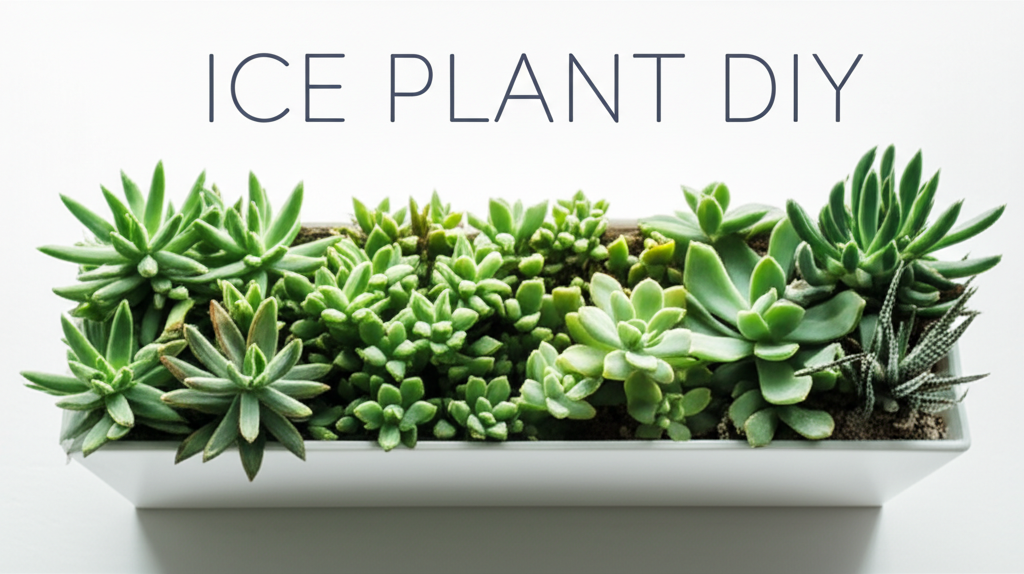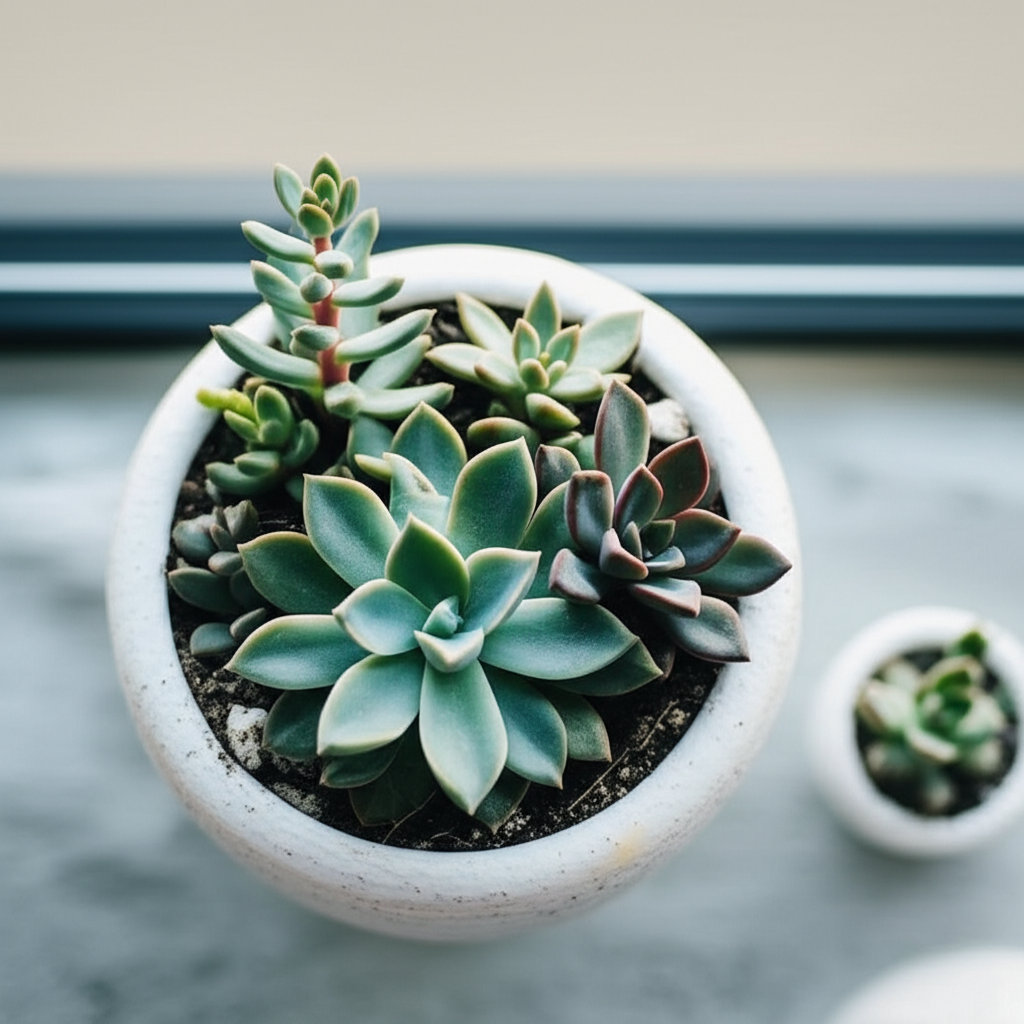Introduction: Bringing the Frosty Charm Indoors
The allure of the ice plant succulent (Mesembryanthemum crystallinum) extends far beyond its captivating, glistening appearance. These hardy, low-maintenance plants, often found gracing arid landscapes, offer a unique opportunity to bring a touch of natural artistry into your home, even on the smallest of balconies. Their characteristic crystalline papillae, which capture dew and reflect sunlight, create a magical, frosty effect, making them a standout choice for any succulent enthusiast. This guide will walk you through the process of creating a stunning DIY indoor ice plant succulent table arrangement, transforming a compact space into a vibrant, textured miniature desert scape. Whether you have a sprawling patio or a modest balcony, this project is designed to be achievable and immensely rewarding, focusing on creating an aesthetic focal point that thrives with minimal fuss.
Why Ice Plant Succulents? The Unique Appeal

Ice plants are more than just visually striking; they possess a range of characteristics that make them ideal for indoor arrangements, especially in limited spaces. Their adaptability to various light conditions (though they prefer bright, indirect light) and their drought-tolerant nature are significant advantages for busy individuals or those new to plant care. The distinctive “ice” coating isn’t just for show; it’s a survival mechanism that helps them retain moisture in dry environments. This, combined with their trailing or clumping growth habits, allows for dynamic and engaging arrangements.
Key Characteristics of Ice Plant Succulents for Arrangements:
- Unique Texture: The crystalline papillae offer a tactile and visual interest unlike any other succulent.
- Drought Tolerance: Perfect for those who occasionally forget to water, reducing the risk of plant death.
- Adaptability: While they love light, they can tolerate a range of indoor conditions.
- Varied Growth Habits: From creeping groundcovers to slightly more upright forms, offering design flexibility.
- Low Maintenance: Generally pest-resistant and requiring minimal fertilization.
Planning Your Tiny Balcony Oasis: Design and Preparation
Before diving into the planting process, careful planning is crucial for a successful and aesthetically pleasing arrangement. Consider the space you have available, the amount of sunlight it receives, and your personal style.
Assessing Your Space and Light Conditions:
- Balcony Size: Measure the dimensions of your table or preferred display area.
- Sunlight Exposure: Observe how many hours of direct and indirect sunlight your space receives throughout the day. Ice plants generally prefer at least 6 hours of bright, indirect light, but can tolerate some direct sun, especially in cooler months. Intense, prolonged direct sun in hot climates might require slight shade.
- Wind Exposure: Balconies can be windy. Consider if your arrangement will be directly exposed to strong gusts, which can dry out soil quickly.
Choosing the Right Container:
The container is the foundation of your arrangement. For a table centerpiece, consider:
- Shallow Bowls: These provide a wide surface area for creating a landscape effect.
- Terracotta Pots: Excellent for drainage and aeration, keeping roots healthy.
- Geometric Planters: Modern and stylish, adding a contemporary edge.
- Repurposed Items: Vintage tins, wooden crates, or even old ceramic bowls can be creatively repurposed.
Ensure your chosen container has adequate drainage holes. If it doesn’t, you’ll need to add them or use a well-draining potting mix with a thick drainage layer.
Selecting Your Ice Plant Succulents and Companions:
While the star is the ice plant, incorporating other succulents can add depth, color, and texture to your arrangement.
- Varieties of Ice Plants: Explore different species of Mesembryanthemum and related genera like Delosperma (Ice Plant family) for diverse forms and colors.
- Complementary Succulents:
Echeveria: Offers rosette shapes and a variety of colors.
Sedum: Many varieties have a trailing habit or attractive foliage.
Sempervivum (Hens and Chicks): Hardy and easy to propagate.
Haworthia: For striking architectural forms and unique patterns.
When selecting plants, consider their mature size and growth habits to ensure they don’t overcrowd each other too quickly.
Key Facts and Comparison: Ice Plant Succulents vs. Common Alternatives
To further illustrate the unique suitability of ice plants, let’s compare them to other popular succulent choices for indoor arrangements.
| Feature | Ice Plant (Mesembryanthemum) | Echeveria | Sedum | Sempervivum |
|---|---|---|---|---|
| Unique Visual Appeal | Crystalline papillae (frosty appearance) | Rosette shapes, vibrant colors | Varied forms, many trailing options | Clumping rosettes, prolific offsets |
| Drought Tolerance | Very High | High | High | Very High |
| Light Requirements | Bright indirect light, tolerates some direct sun | Bright light, prefers direct sun | Bright light, prefers direct sun | Full sun to bright indirect light |
| Watering Needs | Infrequent, allow soil to dry completely | Infrequent, allow soil to dry completely | Infrequent, allow soil to dry completely | Infrequent, allow soil to dry completely |
| Growth Habit | Trailing, spreading, or mounding | Rosette, compact | Trailing, upright, groundcover | Clumping, rosette formation |
| Best For | Adding unique texture, delicate appearance | Color and form focal points | Filling spaces, trailing over edges | Hardiness, creating dense mats |
The DIY Process: Step-by-Step Arrangement Creation
With your plants and materials ready, it’s time to bring your vision to life. This process is enjoyable and allows for creative expression.
Materials You’ll Need:
- Chosen container(s)
- Well-draining succulent or cactus potting mix
- Small gravel or perlite (for extra drainage, optional)
- Selected ice plant succulents and companion plants
- Decorative elements: small stones, pebbles, polished rocks, moss (optional)
- Gloves (optional, for handling spiky succulents)
- Small trowel or spoon
- Watering can with a fine spout
Step-by-Step Guide:
- Prepare the Container: If your container has drainage holes, you’re good to go. If not, consider adding a layer of gravel at the bottom to improve drainage, or drill holes if the material allows.
- Add Potting Mix: Fill the container about two-thirds full with your well-draining succulent mix. You can amend standard potting soil with perlite or coarse sand to improve drainage.
- Arrange Your Plants (Dry Fit): Before planting, place your succulents in the container to visualize the arrangement. Consider height, texture, and color. Place taller plants towards the back or center, and trailing varieties near the edges.
- Planting the Succulents:
Gently remove each succulent from its nursery pot.
Carefully loosen any tightly bound roots.
Dig small holes in the potting mix to accommodate the root balls.
Place each succulent in its hole, ensuring the top of the root ball is slightly below the rim of the container.
Backfill with potting mix, gently firming around the base of each plant to secure it.
- Adding Decorative Elements: Once the plants are in place, you can add your decorative stones, pebbles, or polished rocks. These not only enhance the aesthetic but can also help stabilize smaller plants and retain moisture in the top layer of soil, reducing evaporation.
- Initial Watering (Lightly): After planting, water very lightly. The goal is to settle the soil around the roots, not to drench them. Allow the soil to dry out completely before the next watering.
Care and Maintenance: Keeping Your Arrangement Thriving
Proper care is essential for the longevity and health of your ice plant succulent arrangement. The principles are simple, focusing on what these plants don’t* need as much as what they do.
Watering:
- The Golden Rule: Water only when the soil is completely dry. This can be determined by sticking your finger about an inch into the soil or using a moisture meter.
- How to Water: When watering, water thoroughly until water drains from the bottom. Avoid letting the plants sit in standing water.
- Frequency: This will vary greatly depending on your environment (temperature, humidity, light). In cooler, less sunny conditions, you might water every 2-4 weeks. In warmer, brighter conditions, it might be weekly, but always check soil dryness first.
Light:
- Ideal Conditions: Bright, indirect sunlight is best. A south-facing window that gets intense afternoon sun might be too much, especially in summer. East or west-facing windows often provide excellent light.
- Signs of Too Little Light: Plants may stretch (etiolate), becoming leggy and pale.
- Signs of Too Much Light: Leaves might develop sunburned patches, appearing bleached or brown.
Soil and Fertilizing:
- Soil: Use a specialized succulent or cactus potting mix. Good drainage is paramount.
- Fertilizing: Ice plants are not heavy feeders. Fertilize sparingly, perhaps once or twice during the growing season (spring/summer) with a diluted succulent fertilizer. Over-fertilizing can lead to leggy growth and reduced “frosting.”
Pest Control:
Ice plants are generally resistant to pests. However, occasionally, mealybugs or aphids can appear.
- Identification: Look for white, cottony masses or small green/black insects.
- Treatment: A cotton swab dipped in rubbing alcohol can often remove small infestations. For larger issues, insecticidal soap or neem oil can be used, ensuring to test on a small area first.
Troubleshooting Common Issues
Even with the best intentions, occasional problems can arise. Understanding common issues and their solutions will help you maintain a healthy arrangement.
Overwatering Symptoms:
- Mushy, yellowing leaves: This is the most common sign.
- Rotting at the base: The stem may appear dark and soft.
- Leaf drop: Leaves detach easily from the stem.
- Solution: Stop watering immediately. If the rot is extensive, you may need to propagate healthy cuttings. Ensure excellent drainage and a dry environment.
Underwatering Symptoms:
- Wrinkled or shriveled leaves: The plant is conserving water.
- Dry, brittle leaves: Leaves may eventually fall off.
- Solution: Water thoroughly until water drains from the bottom. Resume your watering schedule, checking soil dryness regularly.
Leggy Growth (Etiolation):
- Cause: Insufficient light.
- Appearance: Long, stretched stems with sparse leaves.
- Solution: Move the plant to a brighter location. You can often propagate the leggy stems by cutting them back, letting them callus, and replanting.
Creative Variations and Enhancements
Once you’ve mastered the basic arrangement, consider these creative twists to elevate your miniature succulent garden.
Themed Arrangements:
- Desert Diorama: Incorporate tiny figurines, miniature houses, or desert-themed rocks.
- Coastal Breeze: Use shells, sea glass, and sand-colored pebbles.
- Zen Garden: Focus on minimalism, smooth stones, and a limited color palette.
Vertical Elements:
If your balcony has vertical space, consider incorporating small hanging planters or a tiered plant stand to add another dimension to your display.
Seasonal Updates:
Succulents are relatively timeless, but you can update the decorative elements seasonally. Think small pumpkins or colourful leaves in autumn, or bright pebbles in spring.
Tabletop Arrangement Pros and Cons
Creating a succulent table arrangement offers distinct advantages, but it’s also important to be aware of potential drawbacks.
| Category | Pros | Cons |
|---|---|---|
| Aesthetics | Unique “frosty” texture and visual appeal | Can be delicate; overhandling might damage papillae |
| Maintenance | Low watering and fertilizing needs | Requires specific light conditions; susceptible to overwatering |
| Space Efficiency | Ideal for small spaces like tiny balconies | Can outgrow containers relatively quickly, requiring repotting |
| Cost | Relatively inexpensive to start; propagation is easy | Can be costly if purchasing many rare varieties |
| Environmental | Drought-tolerant plants conserve water | Requires well-draining soil, which can dry out quickly in hot environments |
Conclusion: Your Balcony’s New Gem
Crafting an ice plant succulent table arrangement is a rewarding journey that brings a unique touch of nature’s artistry to your doorstep. The mesmerizing, frosty appearance of these succulents, combined with their low-maintenance needs, makes them an exceptional choice for any indoor space, especially a tiny balcony. By carefully planning your design, selecting the right plants and container, and adhering to simple care guidelines, you can cultivate a stunning, long-lasting centerpiece that captures the imagination and provides a tranquil green escape. Embrace the process, experiment with your creativity, and enjoy the enchanting beauty your DIY ice plant succulent oasis will undoubtedly bring.


